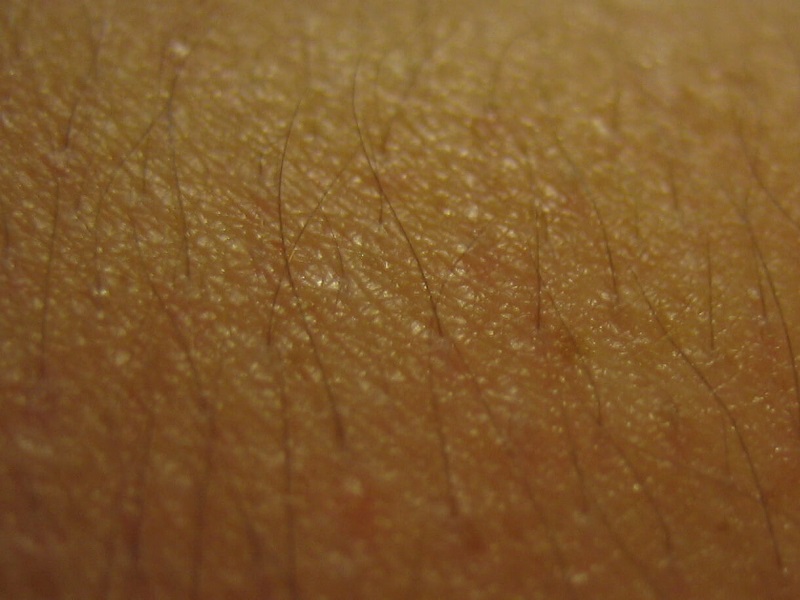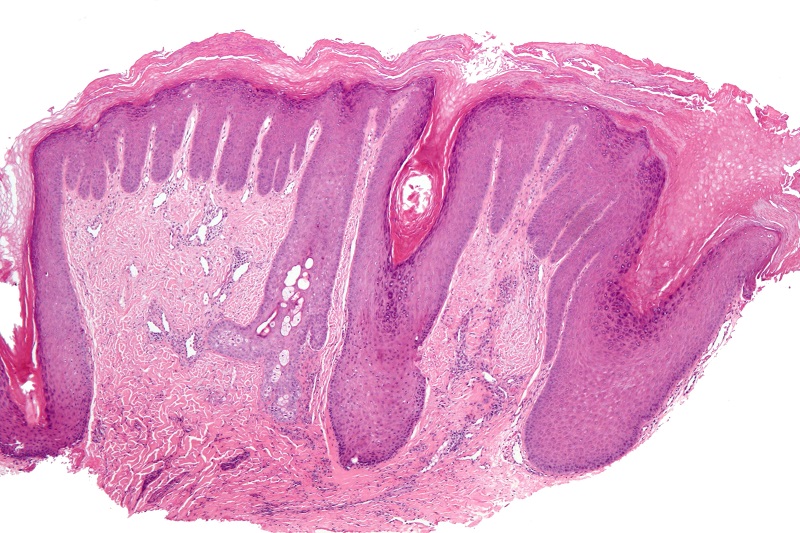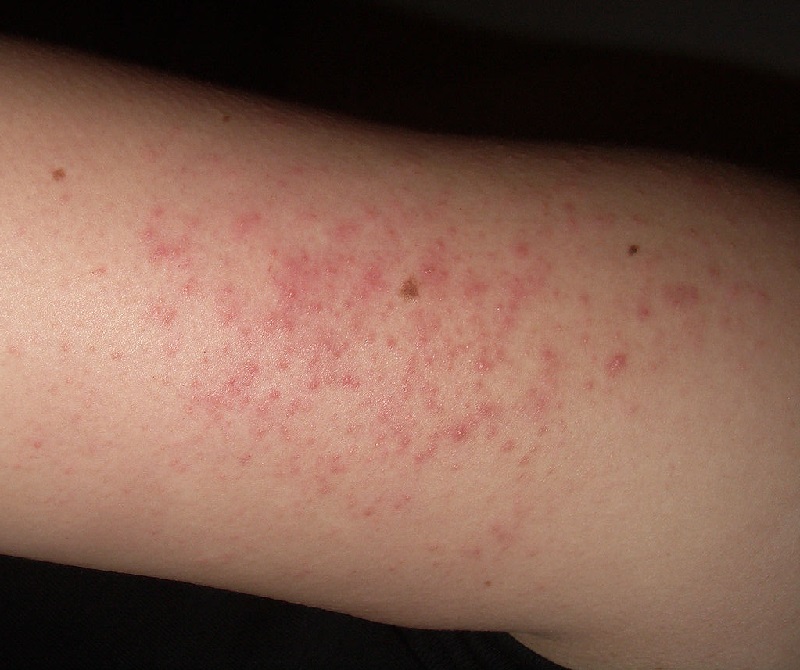How to get rid of chicken skin? Well, there are plenty of ways to treat this condition that are more or less effective. It’s true that some have longer-lasting effects than others, but all of them are temporary. But before jumping into the best ways to treat chicken skin, let’s see what this affection is and what causes it:

What is Chicken Skin?
Medical professionals refer to chicken skin as keratosis pilaris. It is one of the most common skin disorders. The condition is common in patients of all ages and, even though cosmetically undesirable, is completely harmless to our health.
It has been observed that keratosis pilaris usually goes away with age. In fact, the condition mainly affects children and adolescents, peaking at puberty. However, chicken skin in adults is not uncommon. Approximately 80% of adolescents and 40% of adults suffer from keratosis pilaris. Although the condition is difficult to oversee, most patients do not seek medical treatment.
Symptoms of Chicken Skin
Doctors easily identify keratosis pilaris by the small, rough bumps that make the skin look and feel coarse. These are often surrounded by pink areas in light-skinned patients and a slight hyperpigmentation in dark-skinned ones. Apart from visual, tactile stimuli, and occasional itchiness, there are no other symptoms that help us identify keratosis pilaris.
Causes & Types of Chicken Skin
An excess of keratin causes Keratosis pilaris, as the name suggests. However, there are several factors that can worsen the effects of chicken skin.
Causes of Chicken Skin
When our body excessively produces keratin, it clogs hair follicles in our pores. This process is also known as hyperkeratinization and is a consequence of keratosis pilaris. Many chicken skin bumps can contain ingrown hairs, often coiled around themselves. Up to 50% of the patients with chicken skin have a family history of keratosis pilaris. Therefore, experts think the condition is caused by an inherited autosomal dominant gene.
It has been observed that chicken skin is associated with health issues that cause dry skin like xerosis, ichthyosis vulgaris, or atopic dermatitis. Therefore, asthma and skin allergies can also worsen the effects of keratosis pilaris.
Even though the affection is present all year-round, symptoms can aggravate during colder months when there is less moisture in the air. Hormonal changes can also worsen its effects, especially during pregnancy or after giving birth. Keratosis pilaris causes bumps that most often appear on the outer upper arms. However, they can also be present in other parts of the body like the buttocks, thighs, or upper back. Most of the time, the areas affected by chicken skin are symmetrical.

Types of Chicken Skin
Keratosis pilaris atrophicans is a rare type of chicken skin that causes scarring and loss of hair. Keratosis pilaris atrophicans faciei is the specific name for this type of chicken skin on the face. Erythromelanosis follicularis faciei et colli is the condition that affects the face and neck of a patient. The type of chicken skin which affects the eyebrows is called Ulerythema ophryogenes. Keratosis follicularis spinulosa decalvans can only affect the scalp.
Keratosis pilaris alba is the clinical term for milder chicken skin cases where there is no irritation around the keratinous bumps. On the other hand, Keratosis pilaris rubra is the medical name for chicken skin that is also accompanied by redness of the small areas around the keratinous bumps.
Common Questions about Chicken Skin
Is chicken skin dangerous?
No. Chicken skin can appear in healthy individuals, or as a consequence of other skin conditions. Keratosis pilaris by itself does not threaten our health directly, but can cause mental distress in many patients.
Why does chicken skin reappear after exfoliating?
Since the causes of chicken skin are internal, scrubbing will most often only irritate the little keratinous bumps. Even if the condition seems to go away for a few hours, it is not recommended to use this method by itself bcause symptoms will reappear.
How to Get Rid of Chicken Skin
Although the condition does not threat our health, many patients want to treat chicken skin because of the undesirable aspect and texture of the skin. Some are more efficient than others and results differ among patients. However, one thing is common: Keratosis pilaris is a permanent condition that is more than likely to return after treatment. Therefore, patients need to permanently be attentive in order to maintain the results – which will appear a few weeks or even months, by the way.

Here’s how to get rid of keratosis pilaris:
How to Get Rid of Chicken Skin: The Clinical Ways
The most effective way to treat aggravated cases of keratosis pilaris are moisturizing agents or external keratolytic and corticosteroids treatments.
Keratolytic Treatments
These are the ones doctors most often prescribe to patients with aggravated keratosis pilaris. They work by breaking apart dead skin cells that contain keratin. The most used keratolytic agents include alpha hydroxyl acids (like glycolic or lactic acid), urea, retinoids (like vitamin A), salicylic acid, or benzoyl peroxide.
Corticosteroids
Corticosterone, cortisone, and aldosterone are the most common corticosteroids in creams and lotions. However, patients should never use them without a doctor’s recommendation because of their many worrying side effects. If your dermatologist prescribed you an external corticosteroids treatment, always follow their guidelines regarding these substances.
Immunomodulators
For patients with eczema, doctors prescribe immunomodulators without additional treatments. However, they only recommend these treatments to those with severe cases of chicken skin.
Laser Therapy
Intense Pulse Light (in short, IPL) technology is more of a complementary treatment, together with the aforementioned methods. However, it does not treat the keratinous bumps at all – it can only alleviate skin redness that sometimes accompanies chicken skin.
How to Get Rid of Chicken Skin: Over the Counter Remedies
The most efficient chicken skin treatments are prescription or clinical ones. However, many patients treat light cases of chicken skin on arms, legs, or other parts of the body (excluding the face) with over the counter or cosmetic products.
Moisturizers
Hydrating your skin is critical if you want to get rid of chicken skin. If your case is not severe, you can try out cosmetic moisturizers or over the counter ones that contain low doses of the aforementioned active ingredients.
Scrubs
Although harmful if used as a standalone chicken skin treatment, scrubbing can be beneficial when combined with other prescription or over the counter treatments.
How to Get Rid of Chicken Skin: The Natural Ways
Homemade moisturizers and scrubs can be just as effective as mass-produced ones, but cheaper and, sometimes, safer.

Homemade Moisturizers
Plenty of natural substances have moisturizing properties. Although moisturizing might seem strongly related to the water content, oily substances are just as useful for softening the skin.
- Milk is by far the most accessible ingredient or standalone moisturizer.
- Honey is famous for its soothing, antibacterial, and hydrating properties.
- Natural oils: Coconut, Shea, Lavander, Oil, etc.
Homemade Scrubs
Apart from a coarse wash cloth or natural sponge, there are a few natural substances you can use to exfoliate your skin. You can either combine them or use them by themselves:
- If you are not a morning person, you probably have coffee grounds available on a daily basis. They are coarse enough to remove dead skin cells but soft enough not to cause permanent damage. In addition, they also contain natural oils.
- Crystallized honey is another gentle scrub you can use to reduce the number or size of the keratinous bumps on your skin. Since not all honey will crystalize, it will still retain some of its moisturizing and antibacterial properties.
- Powdered cinnamon probably is the mildest exfoliating substance you can find, but this is exactly what makes it perfect as a chicken skin treatment. In addition, it is an anti-microbial and anti-oxidant agent that also increases the blood flow and collagen production.
- Fresh strawberries are the best seasonal treatment you can find. Their seeds act as scrubbing agents, while the flesh of the fruit supplies vitamins and antioxidants.
If you struggle with how to get rid of chicken skin, you might also want to read our article on how to treat dry skin.
Do’s & Don’ts When Having Chicken Skin
- DON’T pick the skin! This can lead to scarring or inflammation. Moreover, it will destroy our body’s natural barrier against microorganisms and can cause serious infections.
- DON’T just scrub! As mentioned before, although it might temporarily alleviate symptoms, it is not a good practice. Excessive scrubbing can irritate and dry the skin, therefore worsening keratosis pilaris. You should only scrub with products specifically created for keratosis pilaris, or use it as a complementary treatment.
- DON’T give up your treatment practices after getting rid of chicken skin! As mentioned before, this condition is permanent and requires constant treatments. However, always talk to your doctor about preventing keratinous bumps to reappear after treatment.
- DON’T take long showers! This strips our skin of its natural oils and dries it out, thus worsening the symptoms of chicken skin.
- DO moisturize at least on a daily basis! Patients should do this all year-round for an overall healthy skin, but pay extra attention to this aspect during winter months.
- DO use plenty of sunscreen! Even though the dry air during the colder months dries out our skin, sun rays have the same effect. Not to mention the high risk of skin cancer you expose yourself to when not using sun protection.
- DO understand that your skin is not as repulsive as you see it! Most of the time, this goes unnoticed by the people we interact with.

How to Get Rid of Chicken Skin – A Short Recap
Chicken skin is one of the few clinically harmless skin conditions, but this doesn’t mean it cannot affect our wellbeing. In fact, its only negative impacts upon our health are of psychological nature. Feeling uncomfortable in our own skin (literally) is reason enough to seek treatment. If you suffer from this condition and struggle with its effects, use our suggestions on how to get rid of chicken skin.
